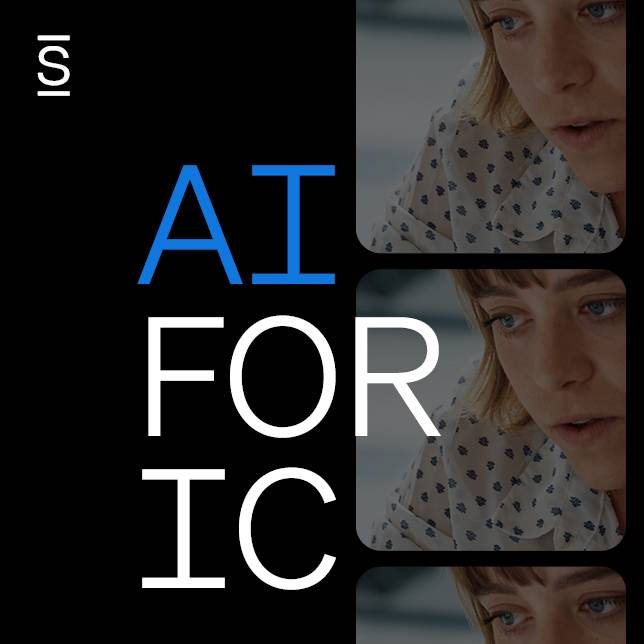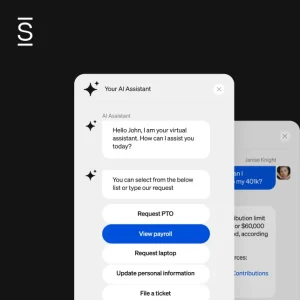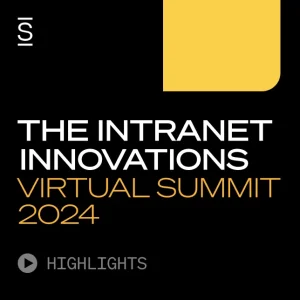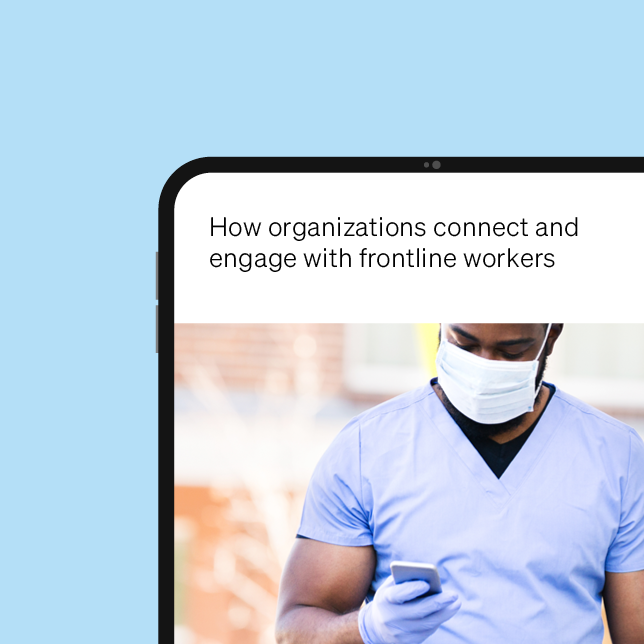This article was originally published on Spiceworks.
Prioritizing core relationships among employees, managers, co-workers, and the organization fosters engagement, productivity, and shared success.
A recent employee engagement survey by Gallup revealed the trend of stagnating employee engagement levels despite ongoing concerted efforts to improve them. As highlighted in this survey, only around a third of U.S. workers feel truly engaged right now — with leadership communication and organizational structure identified as key factors contributing to this trend.
Gallup estimates this level of subpar engagement could be costing an astronomical $1.9 trillion in lost potential.
Amidst this backdrop, navigating the three interwoven circles of employee engagement emerges not only as a strategic imperative but as a pathway towards cultivating a workplace environment where individuals thrive, teams flourish, and organizational goals are achieved with resounding success.
The three circles of employee engagement
To make progress, it is important to take a step back and recognize employee engagement hinges on the quality of relationships an individual has within their workplace. These relationships can be thought of as three concentric circles, each representing a different but interconnected aspect of the workplace experience:
- The relationship between the employee and their manager
- The employee and their co-workers
- The employee with the organization itself
Central to these circles is the employee, whose level of engagement is directly influenced by the interplay of these relationships.
As we seek to build human-centered organizations with people-centric employee experiences at its heart, it is important to understand all of these components. Drivers of employee engagement are complex and dynamic. We need to understand the organizational ecosystem that influences them thoroughly.
Let’s remember that engagement is just one aspect of a holistic employee experience, but it remains important and something for us to continue to pay attention to.
Related: Next in EX — Prioritizing employee experience
The employee-manager dynamic
The relationship between an employee and their manager is perhaps the foundation on which an employee’s engagement is built (beyond their intrinsic motivation). It is central to how employees navigate their professional journey at any organization.
When a manager and their team members foster a trusted relationship characterized by candid exchanges, mutual respect, and an understanding of how their work aligns with the organization’s purpose, it significantly elevates motivation to contribute, personal sense of well-being, and feeling valued.
Conversely, a negative manager-employee relationship can be detrimental and lead to confusion, disillusionment, and decreased motivation. More than this, it can impact a person’s well-being.
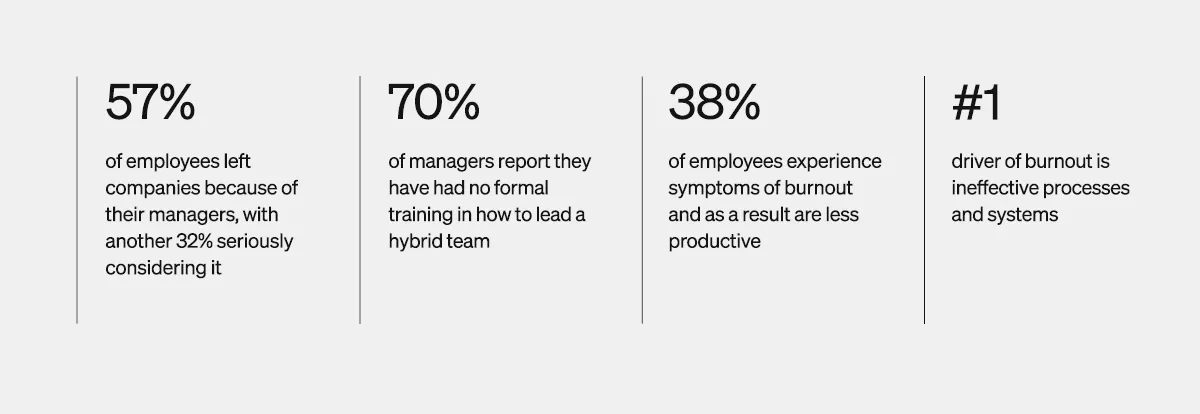
A recent survey reported by Tonya Eckert from The Workforce Institute at UKG found that managers impact employees’ mental health (69%) more than doctors (51%) or therapists (41%) — and even the same as a spouse or partner (69%).
This can have a ripple effect that extends beyond the particular employee, impacting not only the individual performance and well-being but also those around them. Highly engaged individuals exude a positive effect on those who interact with them, and so the reverse is also true.
Related: Importance of good leadership for work-life harmony
Interactions between co-workers
Moving outward, the second circle represents the employee’s relationship with co-workers. Delloite’s 2021 Elevating the Workforce Experience report indicates that positive co-worker interactions can significantly impact workplace outcomes, including job satisfaction, productivity, engagement, and turnover rates.
According to McKinsey, co-workers with trusted relationships and a strong sense of belonging have much lower turnover risk, better job performance, fewer sick days taken, and higher employer satisfaction ratings. This can result in potential annual savings of $52 million in reduced turnover for a 10,000-person organization, according to Adam Smiley Poswolsky of Harvard Business Review.
In contrast, loneliness and isolation are major drivers of employees voluntarily resigning.
Research shows lonely workers cost U.S. companies up to $406 billion per year through higher turnover, lower productivity, more absenteeism, and poorer work quality. Feeling connected to our co-workers matters.
Related: How to forge deeper employee connections with the right technology
Critical role of DEI
In addition, while diversity, equity and inclusion (DEI) are critical throughout the organization, DEI plays a very consequential role under co-worker interactions. McKinesy’s 2023 Diversity Matters Even More report explains why DEI in the workplace significantly impacts coworker relationships by fostering a culture of respect, understanding, and collaboration. It encourages an environment where diverse perspectives are valued, leading to more innovative problem-solving and decision-making.
By promoting equity and inclusion, organizations can create a sense of belonging among employees, reducing conflicts and improving teamwork. An inclusive culture further enhances employee engagement and satisfaction, creating a more cohesive and productive work environment.
Related: Importance of inclusion and diversity in the digital workplace
The organizational connection
The outermost circle represents the employee’s relationship with the organization. One way of thinking about this is the employee experience (EX). It is what it feels like to move through the organization. By definition, employee experience is a distributed phenomenon influenced by all aspects of the organization: its strategy, processes, technology, policies, culture, and more.
This is one of the reasons it is so difficult to deliver a great employee experience consistently. Inconsistency is a challenge. When there’s a gap between how the intended employee experience is defined (the espoused experience) and the actual day-to-day employee experience — this discrepancy leads to increased frustration, decreased performance, and a rise in employee disengagement.
If you work on lifting engagement, you will naturally work on the broader factors that influence your overall employee experience.
It’s a win-win.
Related: Next in EX — Trends shaping employee experience
Crafting an effective workplace environment strategy
A recent SHRM report by business journalist Kathy Gurchiek supports the hypothesis of the multifaceted nature of employee engagement as represented here by the three circles of engagement. It further highlights the critical role of measuring both employee experience and engagement to understand workplace dynamics fully.
Indeed, the three circles of employee engagement — centered around the employee-manager dynamic, coworker interactions, and the organizational connection — resonate with the report’s findings that a holistic approach to understanding and enhancing these aspects can significantly impact overall job satisfaction and reduce turnover.
This alignment underscores the importance of a comprehensive strategy in cultivating a supportive and engaging workplace environment.
There is no single solution for employee engagement. Still, given how we work today, we increasingly demand more technology to help us understand our employees and improve the employee experience. Despite the importance of technology, only about 9% of companies globally report good alignment between their technology and delivering a strong employee experience, according to Willis Towers Watson’s 2021 Employee Experience Survey.
Context switching and digital friction
Most workers have too many tools, which fractures their attention and limits their productivity. The average worker hops across about 35 applications a day, according to the November 2023 Microsoft Work Trend Index, leading to “digital friction.”
Context switching disrupts our ability to stay engaged in the task at hand.
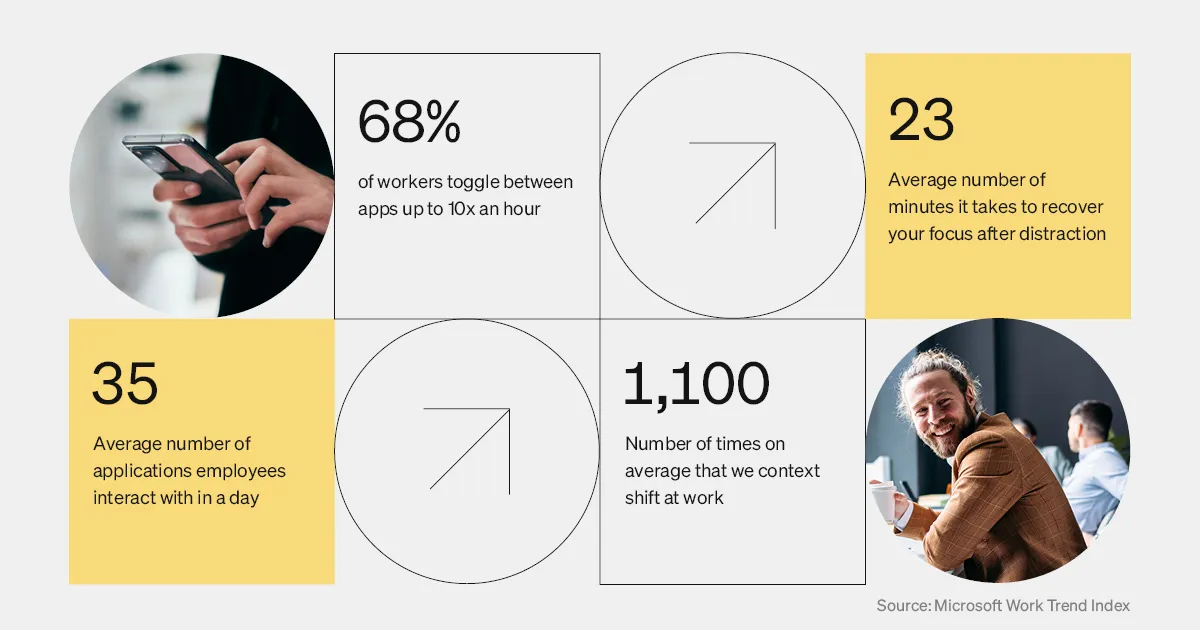
Qualtrics’ Employee Health And Wellbeing At Work report found that the top driver of burnout is inefficient processes and systems.
We need to do better by leveraging technologies to help us create a more personalized and unified experience. Above all, we need to ensure that our technology doesn’t add to the frustration factors. Seeking technologies that can incorporate all these features in one place and integrate seamlessly with other systems where needed is where we are headed. And then, of course, there’s AI.
Related: Next in EX — Unifying employee experience technology
The power and promise of AI
Adding AI to our technology landscape promises a number of benefits. For example, it brings another level of ability to spot patterns in data and moves us much closer to the promise of predictive analytics. One thing AI does best is spot patterns in large volumes of data, which has the potential to serve up useful insights that may previously have taken us either much longer to find or which may have remained hidden. Rich insights that could be derived from analyzing all the data available lie unseen.
Today’s AI-powered employee experience platforms can prompt users to share what they think the second they interact with a post, for example, or prompt them to give honest feedback in reaction to a particular company event.
Cause and effect — action and reaction — can be more clearly understood, helping organizations understand their people, how engaged they are, what support they need, and how to help them be as productive and fulfilled as possible so they can do their best work.
Related: Understanding the role of generative AI in employee-facing applications
AI to increase productivity
Productivity is another big promise of AI. A September 2023 McKinsey study on the future of GenAI estimates that generative AI could automate up to 70% of business activities and bring significant productivity gains — potentially as large as 30% of hours currently worked across the U.S. economy, according to another McKinsey study.
The power and promise of AI are immense, and so is the responsibility of organizations to prepare their workforce to reskill, adapt to change, and take advantage of the possibilities AI brings in a way that enriches the human experience in the workplace.
If your first use cases for AI in the workplace are only about cutting jobs, then you are starting in the wrong place, and you will miss out on the opportunities and innovations AI can bring.
For example, when it comes to making the human experience easier and more fulfilling, AI can make the “work-of-work,” meaning those administrative but necessary, sometimes repetitive, tasks get taken care of by your virtual assistant, or at the very least, made much easier with automated workflows.
Think about how much easier it will be to type, or even simply speak, to your virtual assistant and have it grab the expense receipts you’ve just uploaded from your phone and submit them via the expense system for approval. Or research the answer to an HR question, and while you are there, have the assistant prompt you to take care of an overlooked HR-related task.
According to research done by Topia in July 2020, 60% of employees say that HR tools are disjointed, and 1 in 3 say they’d rather go to the dentist than complete routine HR tasks.
We know that yesterday’s (and let’s be honest, for most of us, today’s) workplace tech is failing us.
Users are frustrated by outdated systems, too many applications hurting productivity, and all of this leading to fragmented insights that impede an organization’s ability to take action.
Using AI responsibly
The expansion of AI across technology in our lives — at work and every day — places an even higher premium on ensuring that our data is handled responsibly and cybersecurity is top-of-mind. Training AI to be our productive virtual assistant places greater reliance on the confidence we have in both the accuracy and currency of the data and content these bots are interrogating or interacting with. And it places greater reliance on us humans using all of this responsibly.
Training our people on how to use AI responsibly, setting policies to guide actions and behaviors, and setting standards on AI development are things we should all be taking action on.
When we are making decisions about which software to purchase, we should be evaluating our service providers on their commitment to responsible AI development by understanding what practices they use, their commitment to cybersecurity, and what industry bodies they are part of, such as the Responsible Artificial Intelligence Institute.
Related: Next in EX — Investing in ‘AI for good’
Human-centered technology for human-centered experiences
While we know technology can only solve so much, it plays an increasingly important role in how we engage, enable, and support our employee experience. Leveraging the right EX platform can make a difference by enabling employees to:
- More easily connect and the organization
- Find greater purpose in their work by understanding how it fits into the bigger picture
- Share their ideas and feedback, feel listened to, and have their opinions valued
- Find what they need, get done what they need to get done, and get on with their day
- Have team analytics at the fingertips of managers so they are supported to understand their people better, build trusted relationships, and engage productively
- Provide easy ways for people to recognize one another, show appreciation, and strengthen connections
When everything else fades away, organizations are about people.
Behind all the metrics and models are human beings longing to feel purpose and belonging, accomplish work that is valued and appreciated, and thrive. To unlock the full potential of every employee, organizations must focus on strengthening the three core relationships — between employees and managers, among coworkers, and with the organization itself — thereby transforming the workplace into a dynamic ecosystem of engagement, productivity, and shared success.










